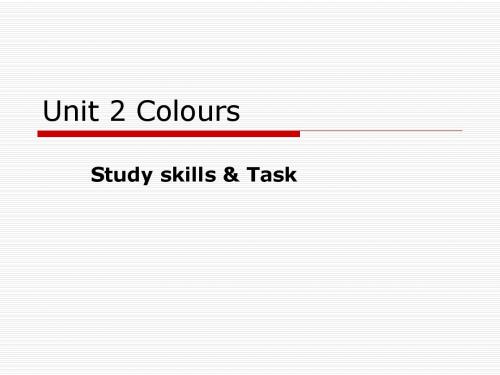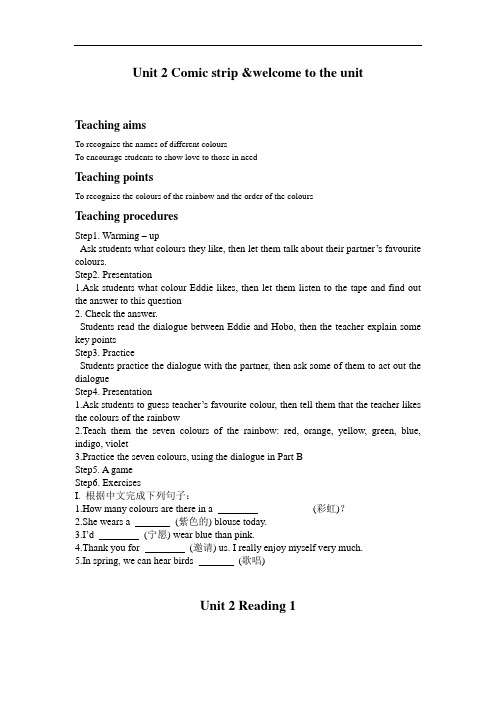9A_Unit2Colors Task
- 格式:ppt
- 大小:2.88 MB
- 文档页数:32





9A Unit 2 Colours一、单元概括重点单词:influence, whether, sadness, create, feeling, require, difficulty, decision, everyday, certainly, personal, ancient, discover, promise, or, work, practice, suggest, trust,match重点短语:cheer up, feel blue, on one’s wedding day, remind…of…, hope for, make a decision, green with envy, have difficulty( in) doing sth., be suitable for, depend on, get back,would rather核心句型:1. But there’s nothing wrong with pink, you know.2. And I’m not sure if blue looks good on you.3. Some people believe that colours can influence our moods.4. Wearing red can also make it easier to take action.5. This may help when you are having difficulty making a decision.6. I’d rather wear orange.单元语法:由that/ if/ whether引导的宾语从句的用法单元话题:谈论颜色书面表达:写自己对颜色的看法或观点的短文Comic strip& Welcome to the unit一、教材知识全解1. But there’s nothing wrong with pink, you know.但是粉红色没有什么不好,你知道的。

Unit 2 Comic strip &welcome to the unitTeaching aimsTo recognize the names of different coloursTo encourage students to show love to those in needTeaching pointsTo recognize the colours of the rainbow and the order of the coloursTeaching proceduresStep1. Warming – upAsk students what colours they like, then let them talk about their partner’s favourite colours.Step2. Presentation1.Ask students what colour Eddie likes, then let them listen to the tape and find out the answer to this question2. Check the answer.Students read the dialogue between Eddie and Hobo, then the teacher explain some key pointsStep3. PracticeStudents practice the dialogue with the partner, then ask some of them to act out the dialogueStep4. Presentation1.Ask students to guess teacher’s favourite colour, then tell them that the teacher likes the colours of the rainbow2.Teach them the seven colours of the rainbow: red, orange, yellow, green, blue, indigo, violet3.Practice the seven colours, using the dialogue in Part BStep5. A gameStep6. ExercisesI. 根据中文完成下列句子:1.How many colours are there in a __________(彩虹)?2.She wears a (紫色的) blouse today.3.I’d (宁愿) wear blue than pink.4.Thank you for (邀请) us. I really enjoy myself very much.5.In spring, we can hear birds (歌唱)Unit 2 Reading 1Teaching aimsTo understand what colours representTo recognize and understand vocabulary about emotionsTeaching pointsTo match colours to the characteristicsTeaching proceduresStep 1: RevisionRevise different kinds of colours by asking students:What’s your favourite colour?Step 2: Presentation.Tell students that different colours can give people different feelings.Let students enjoy a series of pictures, including different kinds of colours and let students discuss:What’s your feeling after looking at the pictures?Encourage students to say as much as possible.Then teachers make a conclusion:Blue & white can make people calm and peaceful. Blue can also represent sadness and white is the colour of purity.Yellow and orange make you feel warm, happy and contented. Orange represents joy while yellow is the colour of wisdom.Green makes you feel energetic. It represents new life and growth.Red represents power. It is also the colour of heat and strong feelings.Step 3: Discussion.Let students think about:How can colour change people’s moods?Encourage students to express himself using his / her own wordsStep4: HomeworkUnit 2 Reading 2Teaching proceduresStep 4: Reading comprehension.1. Ask students to scan the passage quickly and then match the colour with what they represent.Ask students to read the passage again carefully and then fill in the blanks accordingto the passage ArrayStep 5: Language points.1. Ask a student at a time to read a paragraph. After each paragraph, ask students to say which parts of the text they do not understand.2. Explain some difficult language points to students.e.g. remind sb. of sthhave difficulty (in) doing sth.make/ find / think it + adjective + to do sth.Step 6: Discussion1.Ask students what they think about the article. Do they agree with what it says orwhich part of the text do they like most?Unit 2 GrammarTeaching aimsTo know how to use the object clause with ‘that’ and ‘if/whether’.Teaching pointsThe structure and usage of the object clause with ‘that’ and ‘if/whether’.Teaching proceduresStep 1 Lead-inToday we are going to learn the object clauses introduced by ‘that ‘, ‘if/ whether’.Step 2 The Object clauses introduce d by ‘that’1) Earth is becoming more and more crowded and polluted.What does Daniel think ?-- -Daniel thinks that Earth is becoming more and more crowded and polluted.2 ) People will live on the planet Mars by the year 2100.What does Daniel think?---Good . Daniel thinks that people will live on the planet Mars by the year 2100.3) The robot will do most of the work.What does Daniel think?---Yes, Daniel thinks that the robot will do most of the work.Let’s do some exercises. …Have you finished? Now let’s check the answers.1) He’ll be back in a month.(I hear…)--I hear ( that ) he will be back in a month.2) I have been to the Great Wall once.(He tells me…)-- He tells me ( that ) he has been to the Great Wall once.Can you find out the rules about Object clauses introduced by ‘that’?Step 3 The Object clauses in troduced by ‘if ‘or ‘whether’ (PPT)Daniel has learned a lot about living on Mars. But he’s still worrying about something. Look at his worries.1 ) Could the plants produce enough water?--- Daniel is not sure if / whether the planets could produce enough water.2) Are there any aliens on Mars?----Daniel is not sure if / whether there are any aliens on Mars.3) Are animals on Mars dangerous?--- Daniel is not sure if / whether animals on Mars dangerous.Let’s do more practice together.1 ) Does he live in that house? ( She asks me …)---She asks me if/ whether he lives in that house.2) Have you finished your homework? ( I want to know…)---- I want to know if /whether you have finished your homework.Can you work out the rules yourselves?HomeworkUnit 2 Integrated skillsTeaching aims1.To understand the context of an advertisement and a TV demonstration.2. To understand how a color therapist does.3.To get information from a printed advertisement.4.To get further information from a TV interview.5.To consolidation the information gained from reading and listening and determine the facts. Teaching pointsTo learn through different feelings to different colours.Teaching proceduresStep1 RevisionRevise something learned in the last period.Step2 Practice1. Ask the Ss what they think a color therapist is. A color therapist helps people improve their health, mood and appearance by using colors.2. Ask Ss if they believe that colors can affect our mood.3. Explain to Ss that the paper at the top of page 32 is an advertisement. Ask a student to read the advertisement out loud. Tell the students must use the information in the advertisement to complete Millie’s notes. Remind them that they will not be able to complete the note.4. Ask ss to look carefully at what they have written in Part A1, and pay attention to the gaps they have not yet been able to fill in.5. Ask ss to look at their answers. If they still have some questions, play the tape once more without stopping.6. check the mistakes and pronunciation.Step3 PracticeDeal with Part B1. Review “advice”2. Ask one student to play the role of Millie and another one to play the role of Andy.3. Write some vocabulary on the blackboard for students to use. “blouse, coat, tr ousers, loose, tight, comfortable”. Remind students that each color represents something different . Ask them to refer to the passage to check what different colors represent.4. Work in pairs.5. Role—playing.Step4 Sum upSum up some Language pointsStep4 Assignment1. Revise this period and do some exercises2. Pre-learn the next periodUnit 2 TaskTeaching aimsTo master the words: protection, warmth, powerful, handbag, balanceTo organize ideas and build a plan.To write a report about moods and colors and what they represent. 3. To present a report. Teaching pointsTo learn to express ideas to others.Teaching proceduresStep1 RevisionRevise something learned in the last period.Step2 Presentaton1. Explain the context. Students are working on a projectabout the relationship between colors and moods. They willlook at pictures of people and assess their moods based onthe colors they are wearing.2. Tell students that making a list can be a good way toorganize their thoughts and ideas.3. Point out to students that for each color mentioned in the list, there is an explanation of what the colors mean.Step3 Practice1. Tell students to look at the picture carefully, then answersome questions. After answering some questions, let themwork in groups to finish the report.2. Free talk. According to the advertisement on thebook, ask them that what kind of advertisement can beconsidered as good advertisement.3. Show them other pictures and encourage them to talkabout their feeling. About colors and moods. Thenwork in pairs to ask their desk mates about colors andrepresents.4. Exercise: writing.Step 4 Assignment1. Revise this period2. Pre-learn the next periodMore exercises make perfect根据首字母提示完成下列句子:1. Red represents p __________ and s_____________.2. Paul has strong p_________ and likes to be the leader.3. This can help when you have d__________- making a decision.4. I’d r__________ wear a blue coat than a red coat.5. Green can give us e_________ because it r___________ new life and growth.6. White is the color of p________. If you wear white, you will feel p______.7. Blue can c_______ the feeling of harmony.8. Is there a_________ in the room? I’m hungry.9. Do you know that colours can a_________ our moods?10. Orange can bring you s________ .It can c______ you up when you are sad.。
9A Unit2 colours Comic& Welcome(P20-21)1.粉色是女孩的颜色。
2.粉色没什么不好。
3.蓝色穿在你身上好看。
4.你穿蓝色好看。
5.没有颜色这个世界会是个乏味的世界。
6.彩虹的颜色7.一场阵雨8.你知道彩虹中有几种颜色?Pink is a girl’s color.There is nothing wrong with pink.Blue looks good on you.You look good in blue.The world would be a dull place without colors. colors of the rainbowa rain showerDo you know how many colors there are in a rainbow?Reading(Page22-25)1.影响我们的心情2.心情好/坏3.想知道这是否是真的4.使我们感到困倦的5.感到放松的6.把墙刷成蓝色7.冷色调8.蓝色给我们的身心带来平和。
9.代表忧伤/ 快乐10.我感到忧伤。
11.纯洁的颜色12.很多女性喜欢在她们的婚礼上穿白色。
13.更喜欢暖色14.喜爱(做)某事…胜过(做)某事…15.营造一种温暖和舒服的感觉16.使我振作起来17.使我想起温暖而阳光明媚的一天18.希望成功19.她十分羡慕、嫉妒。
20.在身体或精神上需要力气21.对你有帮助22.很重要(2种)23.代表力量和强烈的情感24.穿红色也能使采取行动更容易。
25.做决定有困难26.在作业上有困难27.丹尼尔喜欢蓝色因为它能在他生气时帮助他平静下来。
28.我最喜欢的颜色和我的性格相配/不配。
influence our moodsbe in a good/ bad moodwonder whether it is truemake us feel sleepyfeel relaxedpaint the walls blue 被刷成蓝色be painted bluea calm colourBlue brings peace to our mind and body.represent sadness/ joyI’m feeling blue.the colour of purityMany women like to wear white on their wedding day.prefer warm coloursprefer (doing)sth. to (doing)sthcreate a warm and comfortable feelingcheer me upremind me of a warm and sunny day(remind sb. of sth.)hope for successShe is green with envy.require strength in either body or mindbe of some help to you=be helpful to yoube of great importance= be very importantrepresent power and strong feelingsWearing red can also make it easier to take action.have difficulty making a decision(have difficulty doing sth.)have difficulty with homework(have difficulty with sth)Daniel likes blue because it can help him calm down when he is angry. My favorite color matches/doesn’t match my characteristics.Grammar(Page26-28)1.给她带来好运2.颜色与心情的关系3.在我们的日常生活4.在很多方面5.浅/ 深色6.个人品味7.白衣服适合她。
牛津译林版九年级上册Unit 2《Colour》(Task)教学设计一. 教材分析《Colour》这篇课文选自牛津译林版九年级上册Unit 2,主要介绍了颜色单词和短语以及颜色与心情之间的关系。
通过学习这篇课文,学生可以掌握相关颜色词汇的用法,理解颜色与心情之间的联系,提高他们的语言运用能力和思维能力。
二. 学情分析九年级的学生已经具备了一定的英语基础,颜色词汇和颜色与心情之间的关系也与他们生活息息相关。
但部分学生在口语表达和听力方面还有待提高,因此,在教学过程中,需要关注这部分学生的需求,给予他们更多的关注和帮助。
三. 教学目标1.知识目标:学生能掌握与颜色相关的词汇和短语,如red, yellow,blue, green等。
2.能力目标:学生能够运用所学词汇描述颜色和心情,提高他们的语言运用能力。
3.情感目标:学生能够理解颜色与心情之间的关系,培养他们积极向上的心态。
四. 教学重难点1.教学重点:学生能掌握与颜色相关的词汇和短语,并能够运用它们进行口语表达。
2.教学难点:学生能够理解颜色与心情之间的关系,并在实际情境中运用所学知识。
五. 教学方法1.任务型教学法:通过完成各种任务,引导学生主动参与课堂,提高他们的语言运用能力。
2.情境教学法:创设各种情境,让学生在实际情境中学习颜色词汇和短语,提高他们的口语表达能力。
3.情感教学法:引导学生关注颜色与心情之间的关系,培养他们积极向上的心态。
六. 教学准备1.教学课件:制作课件,包括颜色词汇和短语的图片、例句等。
2.教学素材:准备与颜色相关的图片、视频等素材,用于创设情境。
3.任务单:设计各种任务单,引导学生完成课堂任务。
七. 教学过程1.导入(5分钟)利用图片或视频展示各种颜色,引导学生谈论他们喜欢的颜色,激发学生的学习兴趣。
2.呈现(10分钟)呈现课文中的颜色词汇和短语,如red, yellow, blue, green等,并通过例句展示它们的用法。